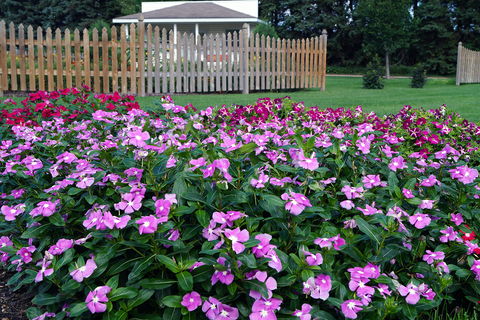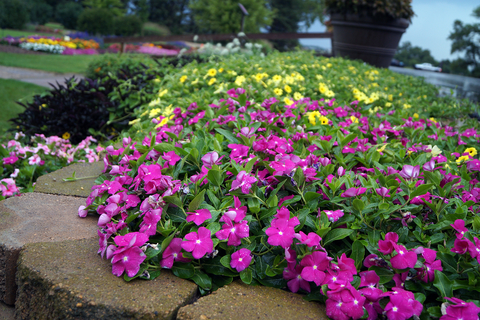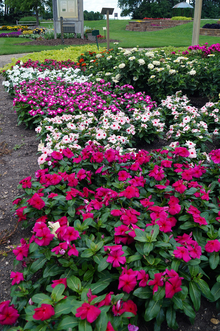Quick facts
- Vincas are heat-loving plants and fairly drought tolerant.
- Vincas grow well in garden beds, containers, and hanging baskets.
- Vincas require full sun and well-draining soil.
- They are low maintenance in terms of pests, diseases and fertilizing.
Annual vincas are also known as periwinkles and are native to semi-arid regions of Africa, which is why they do well in warmer and drier settings.
In addition to having large, brightly colored flowers, vincas also have attractive foliage and are eye-catching even when not in bloom.
Most cultivars grow upright and can reach heights up to 24 inches tall, but some cultivars have more of a trailing habit which makes them great for hanging baskets.
Vincas are sensitive plants as seedlings and do not like it wet, but can tolerate a wide range of conditions once established.
Good performers
Annual vincas are evaluated as part of the U of M flower trials and research. Located at the West Central Research and Outreach Center in Morris, Minn., the Horticulture Display Garden serves as an All-America Selections (AAS) display garden and trail grounds and provides the public an opportunity to view the newest superior performers.
The following annual vinca cultivars were rated good to excellent in our recent trials:
Growing outdoors
Vincas are versatile and perform equally well in garden beds, containers and hanging baskets. They can be planted outdoors once soil temperatures are above 60 degrees F. Plants should be spaced about 12 inches apart.
These are the requirements for choosing a site for vincas:
- Location must have full sun for 8+ hours a day.
- Soil or potting mix must be well drained. To improve drainage, compost or sand can be incorporated into heavy soils.
- Vinca prefer soils with a pH of 5.5-6 but will tolerate high pH soils.
A general-purpose fertilizer with equal amounts of nitrogen, phosphorus and potassium should be incorporated into the soil at time of planting. Vincas do not require fertilizing throughout the season as they are very light feeders. In fact, fertilizing can reduce the number of flowers produced. If you do fertilize, be sure to use it at half the recommended rate.
Vincas need regular watering but do not overwater as they are drought tolerant. Do not water late in the day so that the soil has a chance to dry out before night. Only water when the top 1-2 inches of soil are dry.
Pests and diseases are usually not an issue with this plant. Vincas are susceptible to mildew diseases but it is rarely bad enough to require treatment.
Other tips for abundant blooms and healthy plants:
- If plants are getting leggy it is usually a sign they are not getting enough sunlight.
- Removing old flowers is not necessary and will not promote new growth.
- Water the soil and not the plant to prevent mildew diseases.
- Keep the soil surface clean and weed free to prevent the growth of disease.
Starting seeds indoors
Vinca seeds can be started indoors about 10 weeks prior to the anticipated outdoor planting date. Use a growing media specifically designed for germinating seeds. Follow these guidelines for successful seed propagation:
- Lightly cover the seeds with growing media and cover with vermiculite.
- Keep the seed and media moist by using a plastic cover over the seedling tray.
- Seeds will germinate in 7-21 days at 70-75°F
- After germination, grow plants at 75°F during the day and 65-70°F at night.
- Vinca seedlings are very susceptible to damping off so let media dry out slightly between waterings.
Vinca cuttings
Vincas can be propagated via cuttings as well in about 3-4 weeks.
- Cut 4-6 inches off the top of a stem that does not have flowers.
- Remove the leaves off the bottom half of the cutting.
- Place the cutting in enough water to cover where the leaves were removed.
- Once roots begin to grow, it can be transplanted into soil.
Reviewed in 2021






